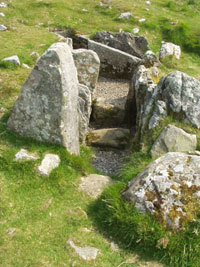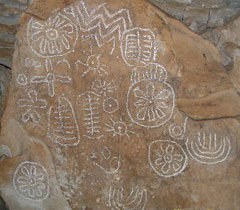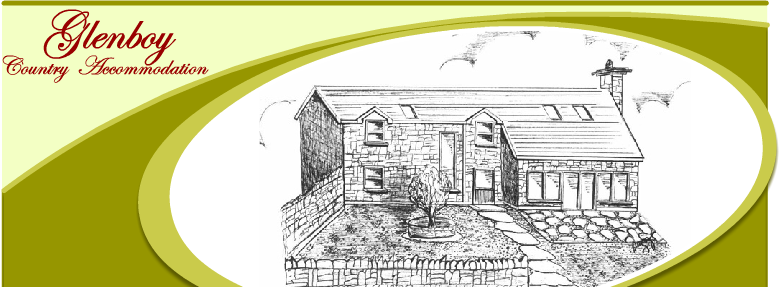|
Loughcrew Cairns
|
|

|
The Loughcrew cairns are a
Stone Age cemetery (c. 3200 BC) comprising some 30 passage tombs, situated on
three hill summits outside Oldcastle. The hills, known collectively as "Sliabh
na Caillighe", or the "Mountain of the Witch" and sometimes "The Storied
Hills", are individually called Carnbane West, Carnbane East (the highest
point in Meath) and Patrickstown. The cairns may be older than Newgrange
(some 40km to the South East) but were only discovered in the Nineteenth
Century by a School Inspector named Eugene Conwell who gave the cairns their
letter names.
One of the best-preserved cairns can still be accessed, Cairn T, the reputed
tomb of the druid, Ollamh Fodhla. Fodhla instituted the Tara triennial feis
and conducted ceremonies on Loughcrew to acquire laws from the spirit world,
which were taken to Tara to be distributed throughout the land by the High
King. |
|
|
|
Cairn T faces the rising sun at the spring and Autumnal Equinoxes which
shines through the passage to illuminate sun symbols at the back of the
chamber. The beam of sunlight is shaped by the upright and the sill stones in
the passageway so that a bright rectangle moves diagonally across the stone
as the sun rises, illuminating each of a series of sun symbols in turn.
According to Frank Prendergast of the Dublin Institute of Technology it
suggests that settlers in the area were familiar with the yearly cycle of the
Sun and perhaps centred their lives around it.
Image courtesy of
http://www.knowth.com/loughcrew.htm |

|
|
|
|
Cairn T is known locally as "the witch's cave" after Garavogue who is said to
have dropped the big heaps of stones from her apron as she hopped across the
hill. On the Cairns north-side is a stone seat known as the Hag's Chair,
where Garavogue sat and watched the stars. A cross carved on the seat dates
from Penal times when open-air masses were held here.
Cairn U, north east of Cairn T, has a stone bisected by a shadow at Summer
Solstice, and its passage is aligned to 4 February and 8 November
cross-quarter days, like the passage tomb at Tara. Cairn V, south east of
Cairn T, marks the winter solstice. Y-shaped Cairn S, north west of Cairn T,
marks sunsets on 6 May and 8 August cross-quarter days. A stone at Cairn N,
south west of Cairn T, aligns on the Hill of Fore to mark the winter solstice
sunset.
|
|

|
|
|
Tombs elsewhere in Ireland point towards the rising Sun at the summer and
winter solstices when the Sun reaches it’s most northerly and southerly
points, which can be easily observed on Earth. The equinoxes - March and
September - are not so obvious and can only be pinpointed by tracking the
passage of the Sun during the year. Why tomb builders did this remains a
mystery but it suggests the Sun was at the heart of their ritual and
ceremonial practices. As Frank Prendergast observed: "They would have
attached a sense of sacredness to their landscape and the sky and they would
have done that by building the monuments the way they did; decorating them
with a kind of rock art; and associating some of these monuments with key
astronomical events such as a significant rising and setting points of the
Moon and Sun."
At the foot of the Loughcrew cairns is Loughcrew gardens birth place of
Oliver Plunkett. Born in in 1629 to a wealthy and well-connected family
Oliver Plunkett returned to Ireland from exile in Rome as Archbishop of
Armagh. He spent a decade on the run “dashing around the countryside on a
fine horse and in a blond wig” practising catholic rites to time when
Catholicism was outlawed. On 1 July 1681, Plunkett became the last Catholic
martyr when he was executed at Tyburn on trumped up treason charges. He was
canonised in 1975, the first new Irish saint for almost seven hundred years.
The family church of St Oliver Plunkett is located in Loughcrew Gardens,
Oldcastle. More Information - see
www.loughcrew.com |
| |
|
|
For further information on
Loughcrew Cairns see
Martin Brennan,
The Stars and the Stones - Ancient Art and
Astronomy in Ireland (Thames
and Hudson, 1983); BBC News (9 April 2003)
http://news.bbc.co.uk/2/hi/science/nature/2928043.stm
Gabriel Cooney, Landscapes of
Neolithic Ireland, (Routledge, 2000)
Jean McMann, Loughcrew: the
cairns: a guide to an ancient Irish landscape (1993)
|

